Uber: Leadership, Management, and Operational Analysis Report
VerifiedAdded on 2023/01/03
|13
|3910
|253
Report
AI Summary
This report provides an in-depth analysis of Uber's operation management practices, focusing on the roles and characteristics of leaders versus managers within the company. It explores how leaders and managers address different situations, including employee issues and change management, highlighting the varying approaches each takes. The report delves into leadership and management theories such as situational, system, and contingency leadership, demonstrating their application within Uber's operational framework. Furthermore, it examines key operation management approaches, including product launches, and discusses the significance of operation management in achieving company objectives, considering the influence of the business environment. The report concludes with a comparative analysis of leader and manager roles, the application of management theories, and the factors influencing operational strategies, providing a comprehensive overview of Uber's operational landscape.
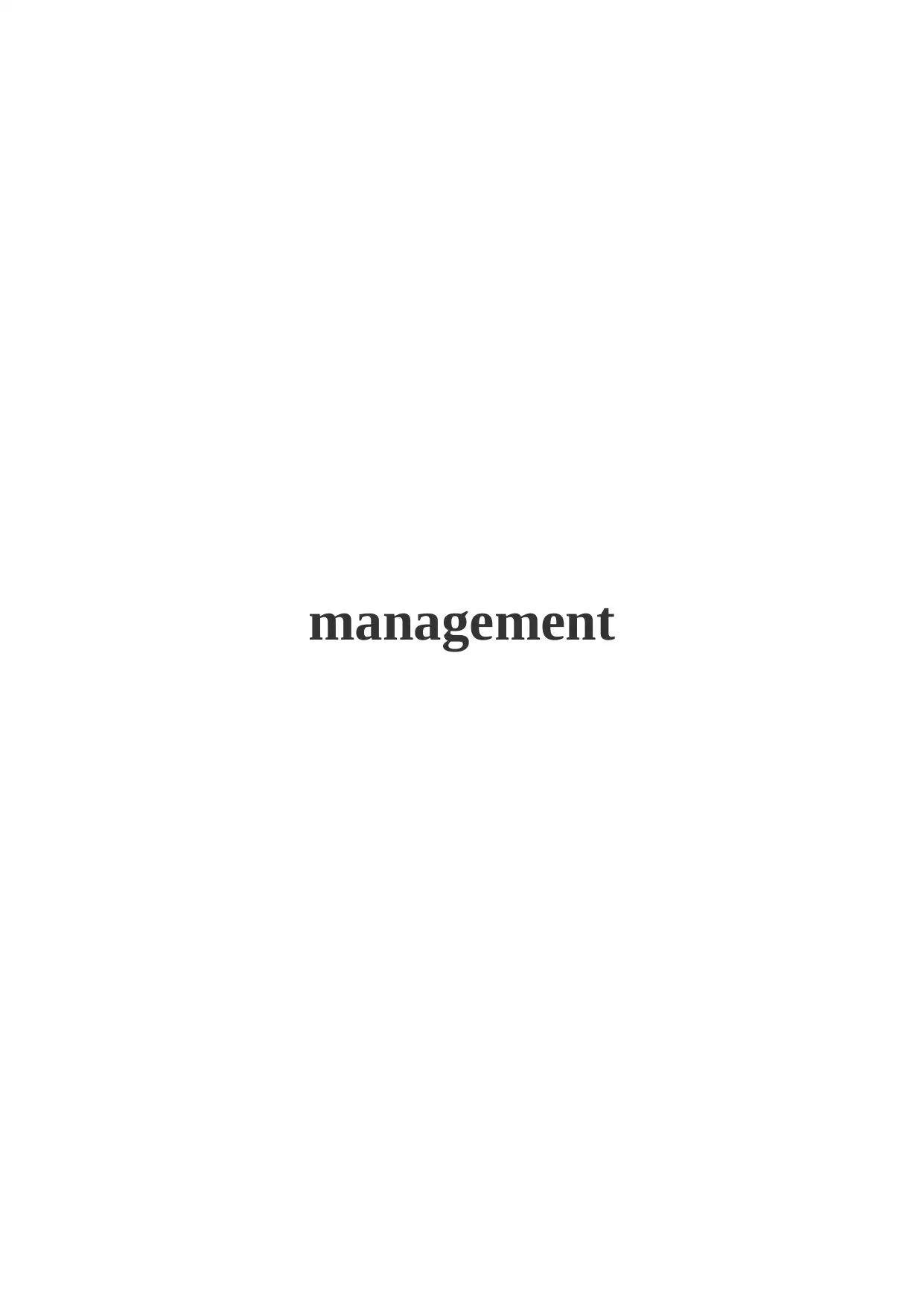
management
Paraphrase This Document
Need a fresh take? Get an instant paraphrase of this document with our AI Paraphraser
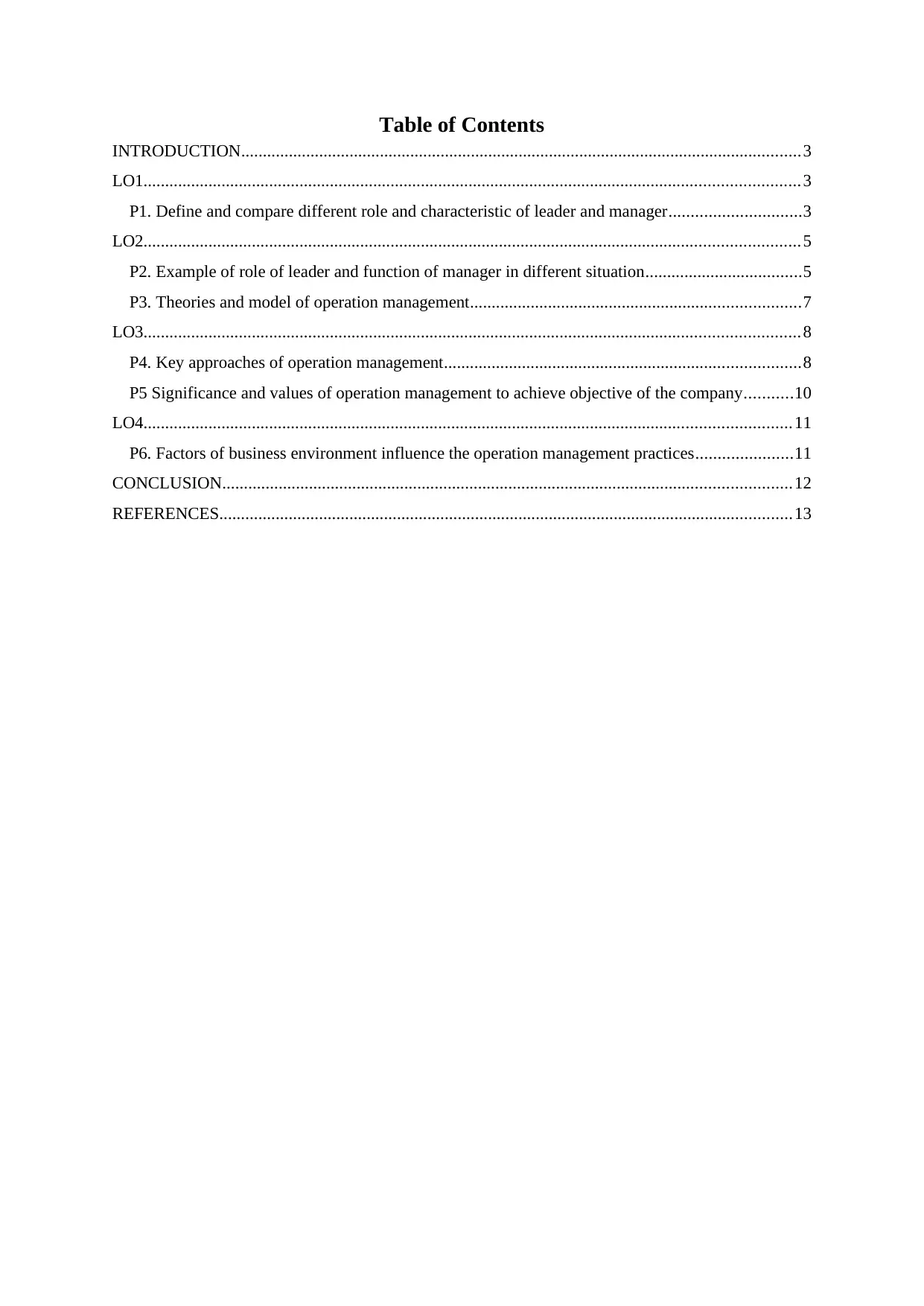
Table of Contents
INTRODUCTION.................................................................................................................................3
LO1.......................................................................................................................................................3
P1. Define and compare different role and characteristic of leader and manager..............................3
LO2.......................................................................................................................................................5
P2. Example of role of leader and function of manager in different situation....................................5
P3. Theories and model of operation management............................................................................7
LO3.......................................................................................................................................................8
P4. Key approaches of operation management..................................................................................8
P5 Significance and values of operation management to achieve objective of the company...........10
LO4.....................................................................................................................................................11
P6. Factors of business environment influence the operation management practices......................11
CONCLUSION...................................................................................................................................12
REFERENCES....................................................................................................................................13
INTRODUCTION.................................................................................................................................3
LO1.......................................................................................................................................................3
P1. Define and compare different role and characteristic of leader and manager..............................3
LO2.......................................................................................................................................................5
P2. Example of role of leader and function of manager in different situation....................................5
P3. Theories and model of operation management............................................................................7
LO3.......................................................................................................................................................8
P4. Key approaches of operation management..................................................................................8
P5 Significance and values of operation management to achieve objective of the company...........10
LO4.....................................................................................................................................................11
P6. Factors of business environment influence the operation management practices......................11
CONCLUSION...................................................................................................................................12
REFERENCES....................................................................................................................................13
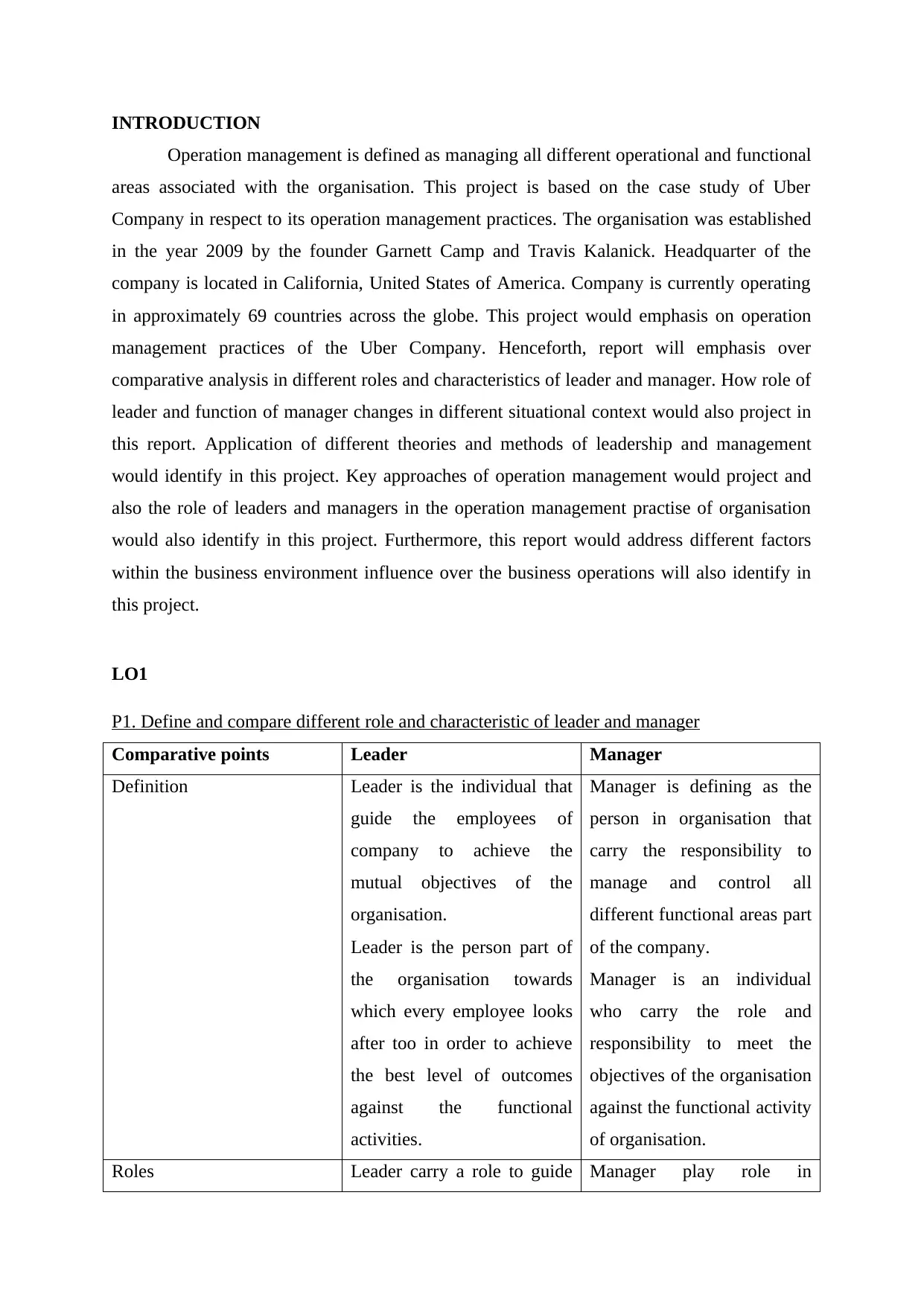
INTRODUCTION
Operation management is defined as managing all different operational and functional
areas associated with the organisation. This project is based on the case study of Uber
Company in respect to its operation management practices. The organisation was established
in the year 2009 by the founder Garnett Camp and Travis Kalanick. Headquarter of the
company is located in California, United States of America. Company is currently operating
in approximately 69 countries across the globe. This project would emphasis on operation
management practices of the Uber Company. Henceforth, report will emphasis over
comparative analysis in different roles and characteristics of leader and manager. How role of
leader and function of manager changes in different situational context would also project in
this report. Application of different theories and methods of leadership and management
would identify in this project. Key approaches of operation management would project and
also the role of leaders and managers in the operation management practise of organisation
would also identify in this project. Furthermore, this report would address different factors
within the business environment influence over the business operations will also identify in
this project.
LO1
P1. Define and compare different role and characteristic of leader and manager
Comparative points Leader Manager
Definition Leader is the individual that
guide the employees of
company to achieve the
mutual objectives of the
organisation.
Leader is the person part of
the organisation towards
which every employee looks
after too in order to achieve
the best level of outcomes
against the functional
activities.
Manager is defining as the
person in organisation that
carry the responsibility to
manage and control all
different functional areas part
of the company.
Manager is an individual
who carry the role and
responsibility to meet the
objectives of the organisation
against the functional activity
of organisation.
Roles Leader carry a role to guide Manager play role in
Operation management is defined as managing all different operational and functional
areas associated with the organisation. This project is based on the case study of Uber
Company in respect to its operation management practices. The organisation was established
in the year 2009 by the founder Garnett Camp and Travis Kalanick. Headquarter of the
company is located in California, United States of America. Company is currently operating
in approximately 69 countries across the globe. This project would emphasis on operation
management practices of the Uber Company. Henceforth, report will emphasis over
comparative analysis in different roles and characteristics of leader and manager. How role of
leader and function of manager changes in different situational context would also project in
this report. Application of different theories and methods of leadership and management
would identify in this project. Key approaches of operation management would project and
also the role of leaders and managers in the operation management practise of organisation
would also identify in this project. Furthermore, this report would address different factors
within the business environment influence over the business operations will also identify in
this project.
LO1
P1. Define and compare different role and characteristic of leader and manager
Comparative points Leader Manager
Definition Leader is the individual that
guide the employees of
company to achieve the
mutual objectives of the
organisation.
Leader is the person part of
the organisation towards
which every employee looks
after too in order to achieve
the best level of outcomes
against the functional
activities.
Manager is defining as the
person in organisation that
carry the responsibility to
manage and control all
different functional areas part
of the company.
Manager is an individual
who carry the role and
responsibility to meet the
objectives of the organisation
against the functional activity
of organisation.
Roles Leader carry a role to guide Manager play role in
⊘ This is a preview!⊘
Do you want full access?
Subscribe today to unlock all pages.

Trusted by 1+ million students worldwide
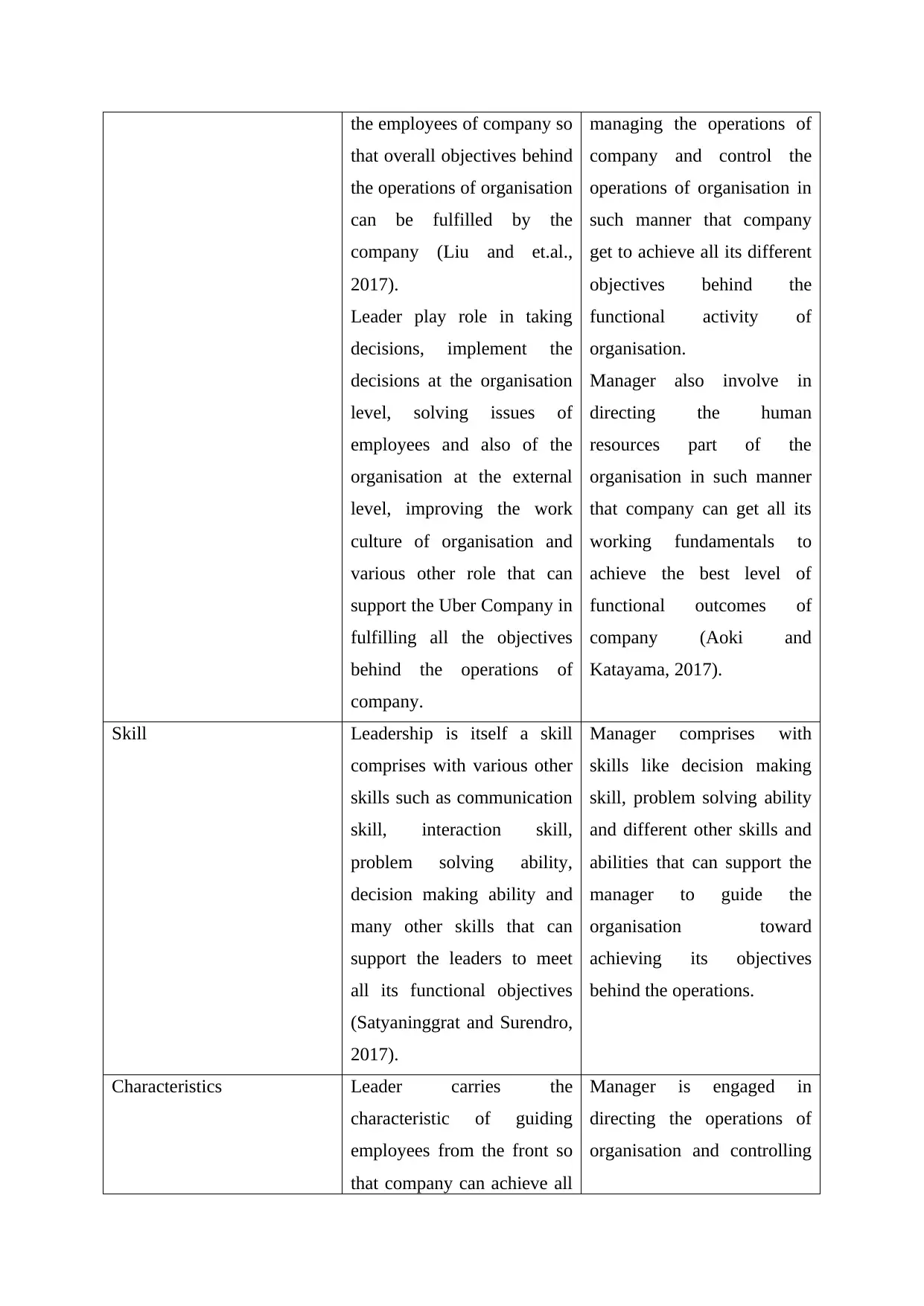
the employees of company so
that overall objectives behind
the operations of organisation
can be fulfilled by the
company (Liu and et.al.,
2017).
Leader play role in taking
decisions, implement the
decisions at the organisation
level, solving issues of
employees and also of the
organisation at the external
level, improving the work
culture of organisation and
various other role that can
support the Uber Company in
fulfilling all the objectives
behind the operations of
company.
managing the operations of
company and control the
operations of organisation in
such manner that company
get to achieve all its different
objectives behind the
functional activity of
organisation.
Manager also involve in
directing the human
resources part of the
organisation in such manner
that company can get all its
working fundamentals to
achieve the best level of
functional outcomes of
company (Aoki and
Katayama, 2017).
Skill Leadership is itself a skill
comprises with various other
skills such as communication
skill, interaction skill,
problem solving ability,
decision making ability and
many other skills that can
support the leaders to meet
all its functional objectives
(Satyaninggrat and Surendro,
2017).
Manager comprises with
skills like decision making
skill, problem solving ability
and different other skills and
abilities that can support the
manager to guide the
organisation toward
achieving its objectives
behind the operations.
Characteristics Leader carries the
characteristic of guiding
employees from the front so
that company can achieve all
Manager is engaged in
directing the operations of
organisation and controlling
that overall objectives behind
the operations of organisation
can be fulfilled by the
company (Liu and et.al.,
2017).
Leader play role in taking
decisions, implement the
decisions at the organisation
level, solving issues of
employees and also of the
organisation at the external
level, improving the work
culture of organisation and
various other role that can
support the Uber Company in
fulfilling all the objectives
behind the operations of
company.
managing the operations of
company and control the
operations of organisation in
such manner that company
get to achieve all its different
objectives behind the
functional activity of
organisation.
Manager also involve in
directing the human
resources part of the
organisation in such manner
that company can get all its
working fundamentals to
achieve the best level of
functional outcomes of
company (Aoki and
Katayama, 2017).
Skill Leadership is itself a skill
comprises with various other
skills such as communication
skill, interaction skill,
problem solving ability,
decision making ability and
many other skills that can
support the leaders to meet
all its functional objectives
(Satyaninggrat and Surendro,
2017).
Manager comprises with
skills like decision making
skill, problem solving ability
and different other skills and
abilities that can support the
manager to guide the
organisation toward
achieving its objectives
behind the operations.
Characteristics Leader carries the
characteristic of guiding
employees from the front so
that company can achieve all
Manager is engaged in
directing the operations of
organisation and controlling
Paraphrase This Document
Need a fresh take? Get an instant paraphrase of this document with our AI Paraphraser
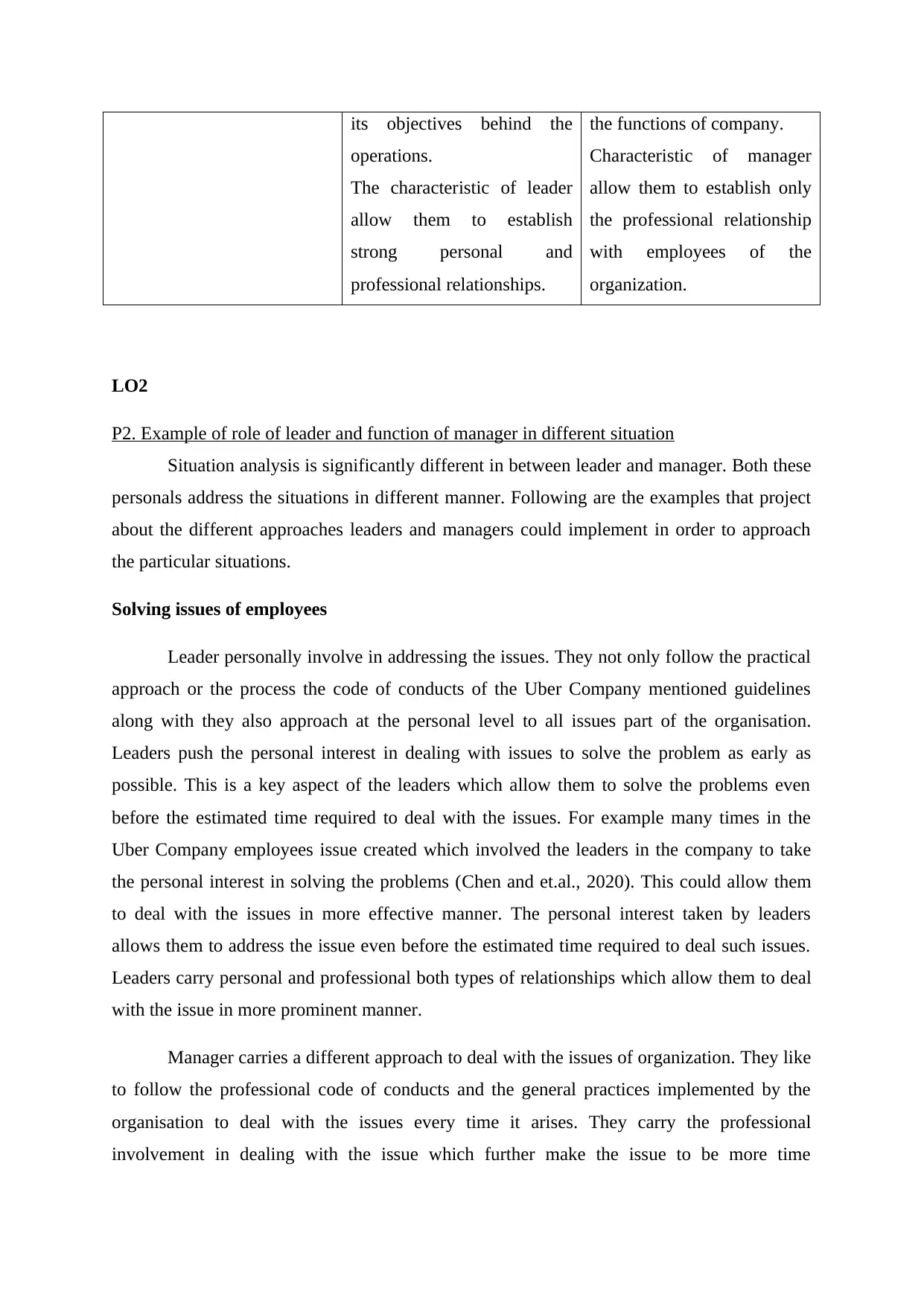
its objectives behind the
operations.
The characteristic of leader
allow them to establish
strong personal and
professional relationships.
the functions of company.
Characteristic of manager
allow them to establish only
the professional relationship
with employees of the
organization.
LO2
P2. Example of role of leader and function of manager in different situation
Situation analysis is significantly different in between leader and manager. Both these
personals address the situations in different manner. Following are the examples that project
about the different approaches leaders and managers could implement in order to approach
the particular situations.
Solving issues of employees
Leader personally involve in addressing the issues. They not only follow the practical
approach or the process the code of conducts of the Uber Company mentioned guidelines
along with they also approach at the personal level to all issues part of the organisation.
Leaders push the personal interest in dealing with issues to solve the problem as early as
possible. This is a key aspect of the leaders which allow them to solve the problems even
before the estimated time required to deal with the issues. For example many times in the
Uber Company employees issue created which involved the leaders in the company to take
the personal interest in solving the problems (Chen and et.al., 2020). This could allow them
to deal with the issues in more effective manner. The personal interest taken by leaders
allows them to address the issue even before the estimated time required to deal such issues.
Leaders carry personal and professional both types of relationships which allow them to deal
with the issue in more prominent manner.
Manager carries a different approach to deal with the issues of organization. They like
to follow the professional code of conducts and the general practices implemented by the
organisation to deal with the issues every time it arises. They carry the professional
involvement in dealing with the issue which further make the issue to be more time
operations.
The characteristic of leader
allow them to establish
strong personal and
professional relationships.
the functions of company.
Characteristic of manager
allow them to establish only
the professional relationship
with employees of the
organization.
LO2
P2. Example of role of leader and function of manager in different situation
Situation analysis is significantly different in between leader and manager. Both these
personals address the situations in different manner. Following are the examples that project
about the different approaches leaders and managers could implement in order to approach
the particular situations.
Solving issues of employees
Leader personally involve in addressing the issues. They not only follow the practical
approach or the process the code of conducts of the Uber Company mentioned guidelines
along with they also approach at the personal level to all issues part of the organisation.
Leaders push the personal interest in dealing with issues to solve the problem as early as
possible. This is a key aspect of the leaders which allow them to solve the problems even
before the estimated time required to deal with the issues. For example many times in the
Uber Company employees issue created which involved the leaders in the company to take
the personal interest in solving the problems (Chen and et.al., 2020). This could allow them
to deal with the issues in more effective manner. The personal interest taken by leaders
allows them to address the issue even before the estimated time required to deal such issues.
Leaders carry personal and professional both types of relationships which allow them to deal
with the issue in more prominent manner.
Manager carries a different approach to deal with the issues of organization. They like
to follow the professional code of conducts and the general practices implemented by the
organisation to deal with the issues every time it arises. They carry the professional
involvement in dealing with the issue which further make the issue to be more time
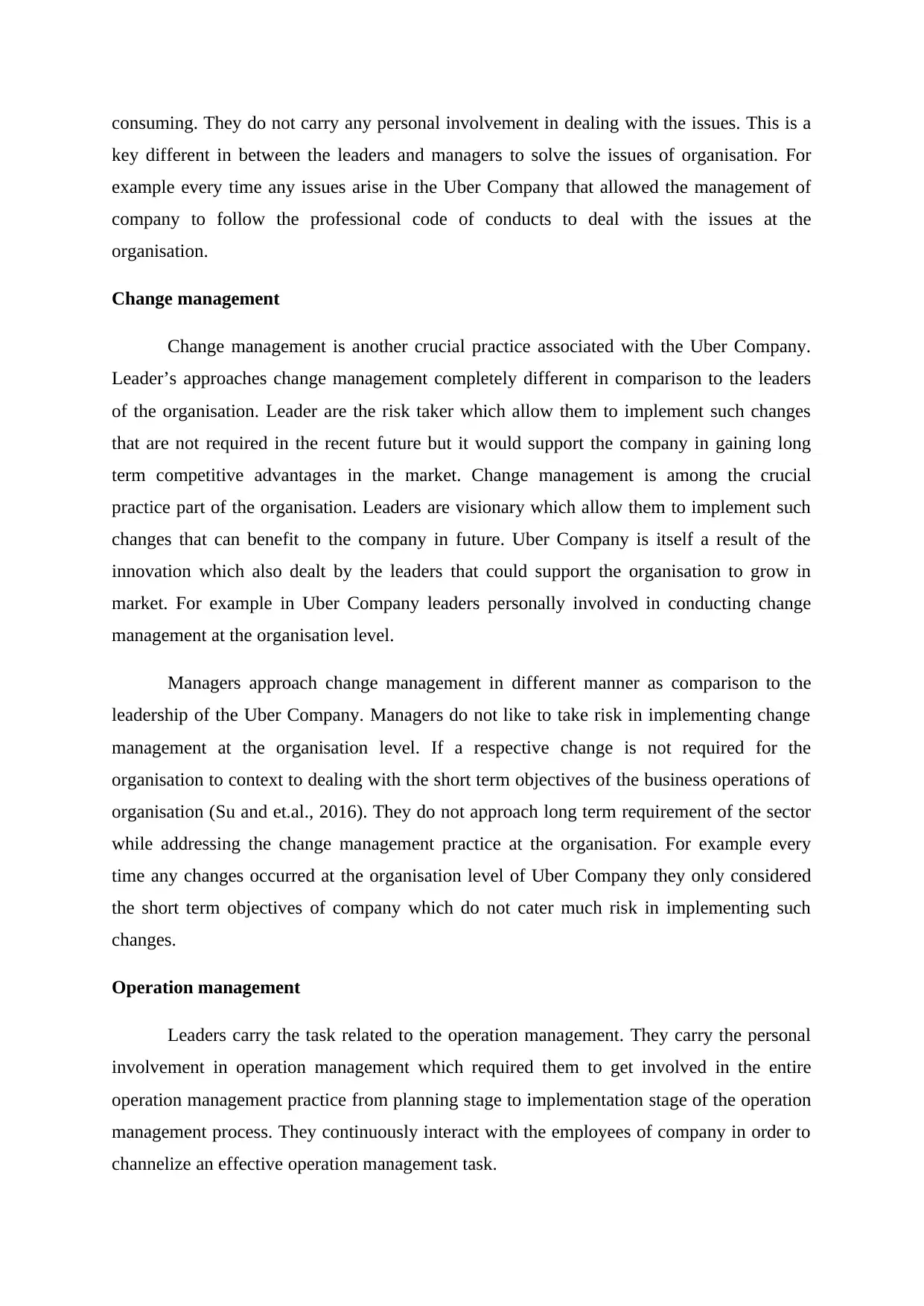
consuming. They do not carry any personal involvement in dealing with the issues. This is a
key different in between the leaders and managers to solve the issues of organisation. For
example every time any issues arise in the Uber Company that allowed the management of
company to follow the professional code of conducts to deal with the issues at the
organisation.
Change management
Change management is another crucial practice associated with the Uber Company.
Leader’s approaches change management completely different in comparison to the leaders
of the organisation. Leader are the risk taker which allow them to implement such changes
that are not required in the recent future but it would support the company in gaining long
term competitive advantages in the market. Change management is among the crucial
practice part of the organisation. Leaders are visionary which allow them to implement such
changes that can benefit to the company in future. Uber Company is itself a result of the
innovation which also dealt by the leaders that could support the organisation to grow in
market. For example in Uber Company leaders personally involved in conducting change
management at the organisation level.
Managers approach change management in different manner as comparison to the
leadership of the Uber Company. Managers do not like to take risk in implementing change
management at the organisation level. If a respective change is not required for the
organisation to context to dealing with the short term objectives of the business operations of
organisation (Su and et.al., 2016). They do not approach long term requirement of the sector
while addressing the change management practice at the organisation. For example every
time any changes occurred at the organisation level of Uber Company they only considered
the short term objectives of company which do not cater much risk in implementing such
changes.
Operation management
Leaders carry the task related to the operation management. They carry the personal
involvement in operation management which required them to get involved in the entire
operation management practice from planning stage to implementation stage of the operation
management process. They continuously interact with the employees of company in order to
channelize an effective operation management task.
key different in between the leaders and managers to solve the issues of organisation. For
example every time any issues arise in the Uber Company that allowed the management of
company to follow the professional code of conducts to deal with the issues at the
organisation.
Change management
Change management is another crucial practice associated with the Uber Company.
Leader’s approaches change management completely different in comparison to the leaders
of the organisation. Leader are the risk taker which allow them to implement such changes
that are not required in the recent future but it would support the company in gaining long
term competitive advantages in the market. Change management is among the crucial
practice part of the organisation. Leaders are visionary which allow them to implement such
changes that can benefit to the company in future. Uber Company is itself a result of the
innovation which also dealt by the leaders that could support the organisation to grow in
market. For example in Uber Company leaders personally involved in conducting change
management at the organisation level.
Managers approach change management in different manner as comparison to the
leadership of the Uber Company. Managers do not like to take risk in implementing change
management at the organisation level. If a respective change is not required for the
organisation to context to dealing with the short term objectives of the business operations of
organisation (Su and et.al., 2016). They do not approach long term requirement of the sector
while addressing the change management practice at the organisation. For example every
time any changes occurred at the organisation level of Uber Company they only considered
the short term objectives of company which do not cater much risk in implementing such
changes.
Operation management
Leaders carry the task related to the operation management. They carry the personal
involvement in operation management which required them to get involved in the entire
operation management practice from planning stage to implementation stage of the operation
management process. They continuously interact with the employees of company in order to
channelize an effective operation management task.
⊘ This is a preview!⊘
Do you want full access?
Subscribe today to unlock all pages.

Trusted by 1+ million students worldwide
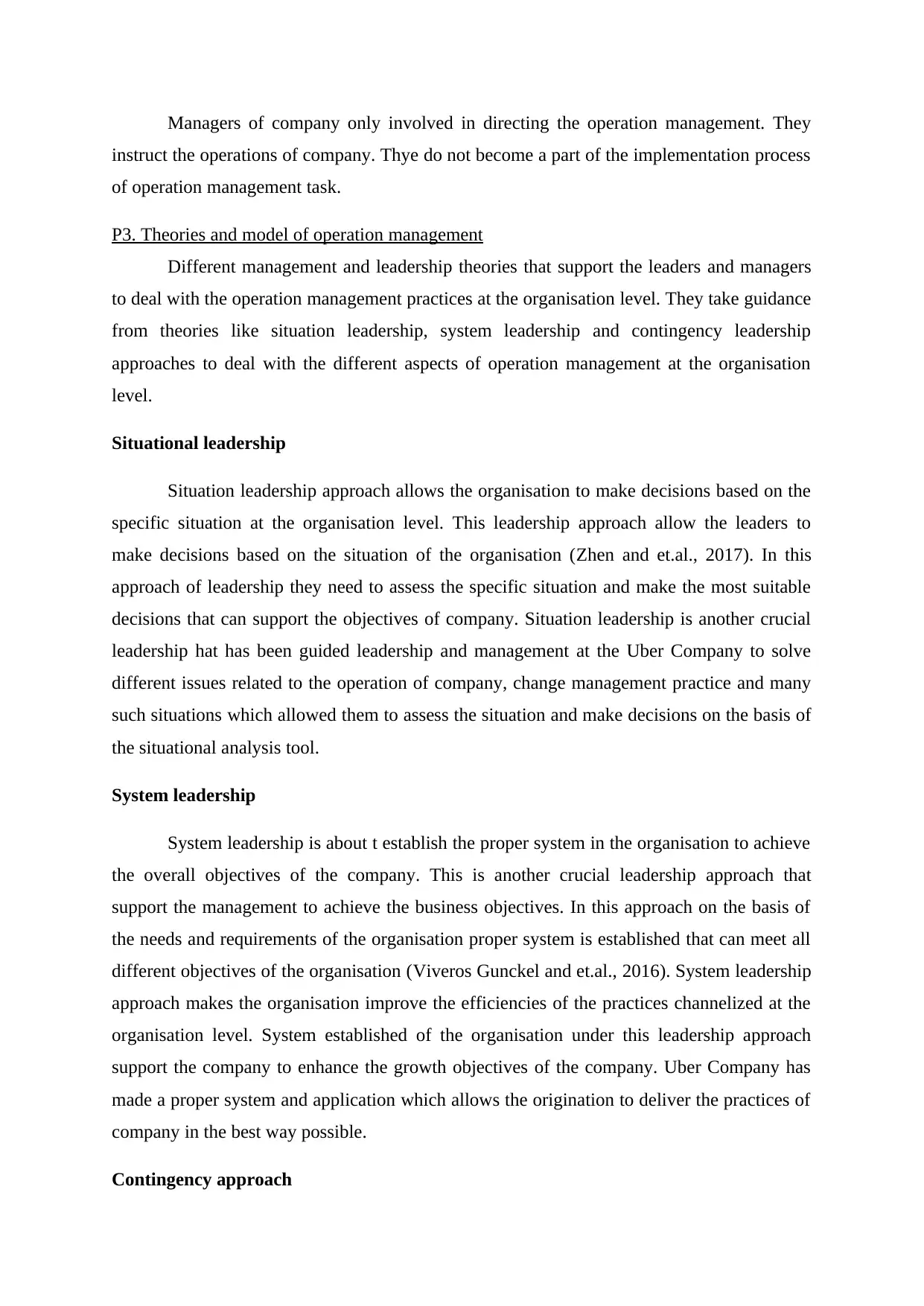
Managers of company only involved in directing the operation management. They
instruct the operations of company. Thye do not become a part of the implementation process
of operation management task.
P3. Theories and model of operation management
Different management and leadership theories that support the leaders and managers
to deal with the operation management practices at the organisation level. They take guidance
from theories like situation leadership, system leadership and contingency leadership
approaches to deal with the different aspects of operation management at the organisation
level.
Situational leadership
Situation leadership approach allows the organisation to make decisions based on the
specific situation at the organisation level. This leadership approach allow the leaders to
make decisions based on the situation of the organisation (Zhen and et.al., 2017). In this
approach of leadership they need to assess the specific situation and make the most suitable
decisions that can support the objectives of company. Situation leadership is another crucial
leadership hat has been guided leadership and management at the Uber Company to solve
different issues related to the operation of company, change management practice and many
such situations which allowed them to assess the situation and make decisions on the basis of
the situational analysis tool.
System leadership
System leadership is about t establish the proper system in the organisation to achieve
the overall objectives of the company. This is another crucial leadership approach that
support the management to achieve the business objectives. In this approach on the basis of
the needs and requirements of the organisation proper system is established that can meet all
different objectives of the organisation (Viveros Gunckel and et.al., 2016). System leadership
approach makes the organisation improve the efficiencies of the practices channelized at the
organisation level. System established of the organisation under this leadership approach
support the company to enhance the growth objectives of the company. Uber Company has
made a proper system and application which allows the origination to deliver the practices of
company in the best way possible.
Contingency approach
instruct the operations of company. Thye do not become a part of the implementation process
of operation management task.
P3. Theories and model of operation management
Different management and leadership theories that support the leaders and managers
to deal with the operation management practices at the organisation level. They take guidance
from theories like situation leadership, system leadership and contingency leadership
approaches to deal with the different aspects of operation management at the organisation
level.
Situational leadership
Situation leadership approach allows the organisation to make decisions based on the
specific situation at the organisation level. This leadership approach allow the leaders to
make decisions based on the situation of the organisation (Zhen and et.al., 2017). In this
approach of leadership they need to assess the specific situation and make the most suitable
decisions that can support the objectives of company. Situation leadership is another crucial
leadership hat has been guided leadership and management at the Uber Company to solve
different issues related to the operation of company, change management practice and many
such situations which allowed them to assess the situation and make decisions on the basis of
the situational analysis tool.
System leadership
System leadership is about t establish the proper system in the organisation to achieve
the overall objectives of the company. This is another crucial leadership approach that
support the management to achieve the business objectives. In this approach on the basis of
the needs and requirements of the organisation proper system is established that can meet all
different objectives of the organisation (Viveros Gunckel and et.al., 2016). System leadership
approach makes the organisation improve the efficiencies of the practices channelized at the
organisation level. System established of the organisation under this leadership approach
support the company to enhance the growth objectives of the company. Uber Company has
made a proper system and application which allows the origination to deliver the practices of
company in the best way possible.
Contingency approach
Paraphrase This Document
Need a fresh take? Get an instant paraphrase of this document with our AI Paraphraser
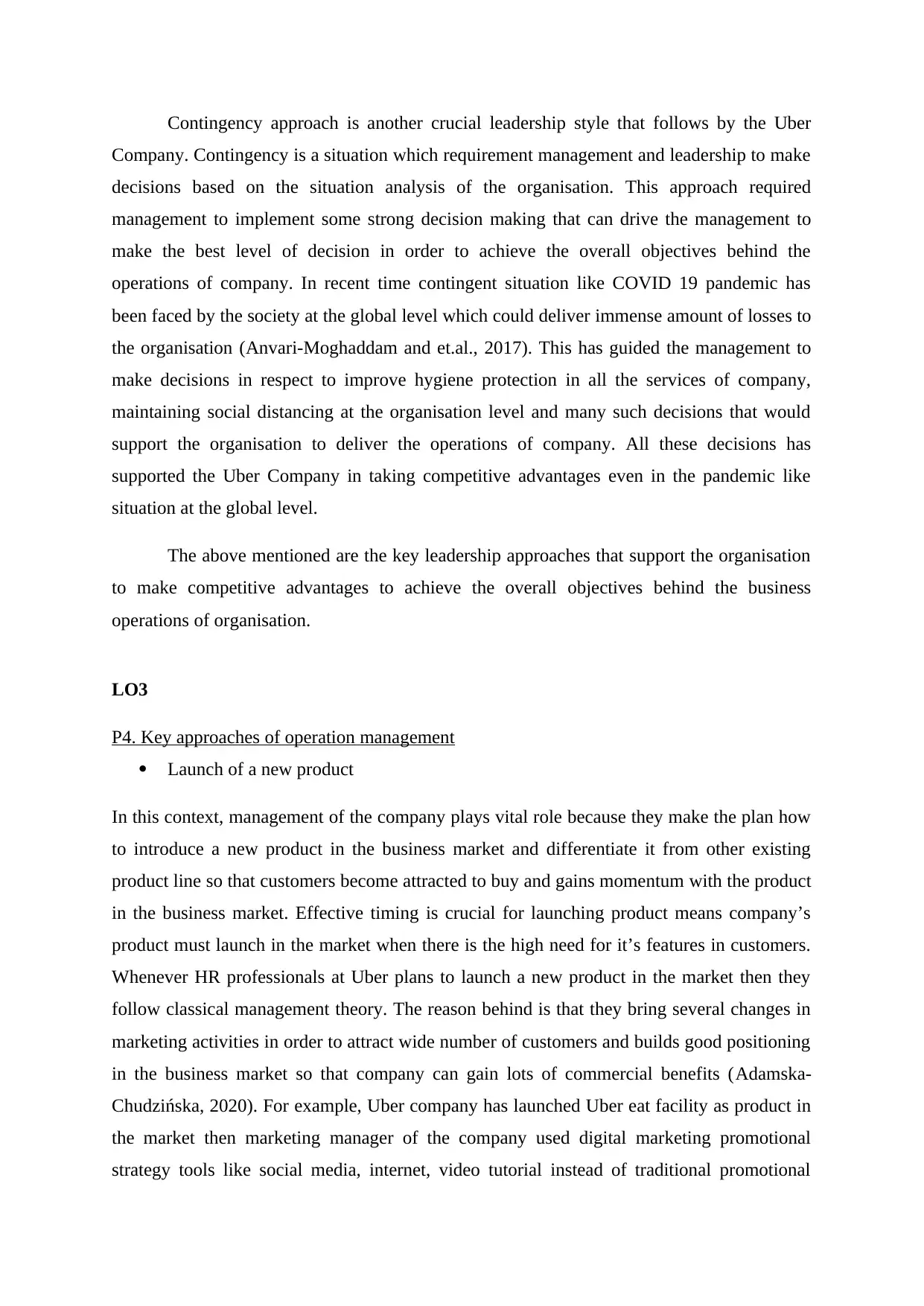
Contingency approach is another crucial leadership style that follows by the Uber
Company. Contingency is a situation which requirement management and leadership to make
decisions based on the situation analysis of the organisation. This approach required
management to implement some strong decision making that can drive the management to
make the best level of decision in order to achieve the overall objectives behind the
operations of company. In recent time contingent situation like COVID 19 pandemic has
been faced by the society at the global level which could deliver immense amount of losses to
the organisation (Anvari-Moghaddam and et.al., 2017). This has guided the management to
make decisions in respect to improve hygiene protection in all the services of company,
maintaining social distancing at the organisation level and many such decisions that would
support the organisation to deliver the operations of company. All these decisions has
supported the Uber Company in taking competitive advantages even in the pandemic like
situation at the global level.
The above mentioned are the key leadership approaches that support the organisation
to make competitive advantages to achieve the overall objectives behind the business
operations of organisation.
LO3
P4. Key approaches of operation management
Launch of a new product
In this context, management of the company plays vital role because they make the plan how
to introduce a new product in the business market and differentiate it from other existing
product line so that customers become attracted to buy and gains momentum with the product
in the business market. Effective timing is crucial for launching product means company’s
product must launch in the market when there is the high need for it’s features in customers.
Whenever HR professionals at Uber plans to launch a new product in the market then they
follow classical management theory. The reason behind is that they bring several changes in
marketing activities in order to attract wide number of customers and builds good positioning
in the business market so that company can gain lots of commercial benefits (Adamska-
Chudzińska, 2020). For example, Uber company has launched Uber eat facility as product in
the market then marketing manager of the company used digital marketing promotional
strategy tools like social media, internet, video tutorial instead of traditional promotional
Company. Contingency is a situation which requirement management and leadership to make
decisions based on the situation analysis of the organisation. This approach required
management to implement some strong decision making that can drive the management to
make the best level of decision in order to achieve the overall objectives behind the
operations of company. In recent time contingent situation like COVID 19 pandemic has
been faced by the society at the global level which could deliver immense amount of losses to
the organisation (Anvari-Moghaddam and et.al., 2017). This has guided the management to
make decisions in respect to improve hygiene protection in all the services of company,
maintaining social distancing at the organisation level and many such decisions that would
support the organisation to deliver the operations of company. All these decisions has
supported the Uber Company in taking competitive advantages even in the pandemic like
situation at the global level.
The above mentioned are the key leadership approaches that support the organisation
to make competitive advantages to achieve the overall objectives behind the business
operations of organisation.
LO3
P4. Key approaches of operation management
Launch of a new product
In this context, management of the company plays vital role because they make the plan how
to introduce a new product in the business market and differentiate it from other existing
product line so that customers become attracted to buy and gains momentum with the product
in the business market. Effective timing is crucial for launching product means company’s
product must launch in the market when there is the high need for it’s features in customers.
Whenever HR professionals at Uber plans to launch a new product in the market then they
follow classical management theory. The reason behind is that they bring several changes in
marketing activities in order to attract wide number of customers and builds good positioning
in the business market so that company can gain lots of commercial benefits (Adamska-
Chudzińska, 2020). For example, Uber company has launched Uber eat facility as product in
the market then marketing manager of the company used digital marketing promotional
strategy tools like social media, internet, video tutorial instead of traditional promotional
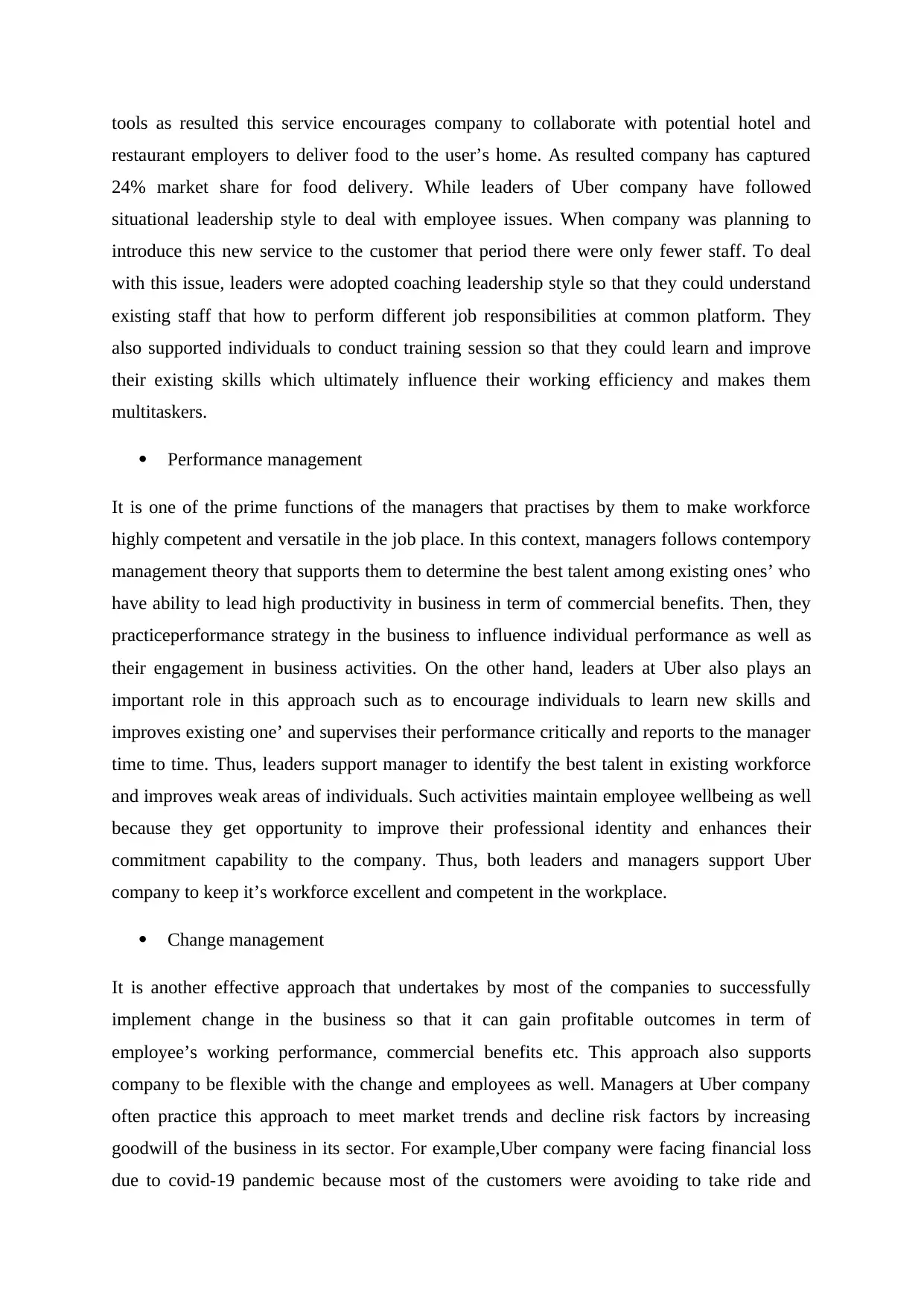
tools as resulted this service encourages company to collaborate with potential hotel and
restaurant employers to deliver food to the user’s home. As resulted company has captured
24% market share for food delivery. While leaders of Uber company have followed
situational leadership style to deal with employee issues. When company was planning to
introduce this new service to the customer that period there were only fewer staff. To deal
with this issue, leaders were adopted coaching leadership style so that they could understand
existing staff that how to perform different job responsibilities at common platform. They
also supported individuals to conduct training session so that they could learn and improve
their existing skills which ultimately influence their working efficiency and makes them
multitaskers.
Performance management
It is one of the prime functions of the managers that practises by them to make workforce
highly competent and versatile in the job place. In this context, managers follows contempory
management theory that supports them to determine the best talent among existing ones’ who
have ability to lead high productivity in business in term of commercial benefits. Then, they
practiceperformance strategy in the business to influence individual performance as well as
their engagement in business activities. On the other hand, leaders at Uber also plays an
important role in this approach such as to encourage individuals to learn new skills and
improves existing one’ and supervises their performance critically and reports to the manager
time to time. Thus, leaders support manager to identify the best talent in existing workforce
and improves weak areas of individuals. Such activities maintain employee wellbeing as well
because they get opportunity to improve their professional identity and enhances their
commitment capability to the company. Thus, both leaders and managers support Uber
company to keep it’s workforce excellent and competent in the workplace.
Change management
It is another effective approach that undertakes by most of the companies to successfully
implement change in the business so that it can gain profitable outcomes in term of
employee’s working performance, commercial benefits etc. This approach also supports
company to be flexible with the change and employees as well. Managers at Uber company
often practice this approach to meet market trends and decline risk factors by increasing
goodwill of the business in its sector. For example,Uber company were facing financial loss
due to covid-19 pandemic because most of the customers were avoiding to take ride and
restaurant employers to deliver food to the user’s home. As resulted company has captured
24% market share for food delivery. While leaders of Uber company have followed
situational leadership style to deal with employee issues. When company was planning to
introduce this new service to the customer that period there were only fewer staff. To deal
with this issue, leaders were adopted coaching leadership style so that they could understand
existing staff that how to perform different job responsibilities at common platform. They
also supported individuals to conduct training session so that they could learn and improve
their existing skills which ultimately influence their working efficiency and makes them
multitaskers.
Performance management
It is one of the prime functions of the managers that practises by them to make workforce
highly competent and versatile in the job place. In this context, managers follows contempory
management theory that supports them to determine the best talent among existing ones’ who
have ability to lead high productivity in business in term of commercial benefits. Then, they
practiceperformance strategy in the business to influence individual performance as well as
their engagement in business activities. On the other hand, leaders at Uber also plays an
important role in this approach such as to encourage individuals to learn new skills and
improves existing one’ and supervises their performance critically and reports to the manager
time to time. Thus, leaders support manager to identify the best talent in existing workforce
and improves weak areas of individuals. Such activities maintain employee wellbeing as well
because they get opportunity to improve their professional identity and enhances their
commitment capability to the company. Thus, both leaders and managers support Uber
company to keep it’s workforce excellent and competent in the workplace.
Change management
It is another effective approach that undertakes by most of the companies to successfully
implement change in the business so that it can gain profitable outcomes in term of
employee’s working performance, commercial benefits etc. This approach also supports
company to be flexible with the change and employees as well. Managers at Uber company
often practice this approach to meet market trends and decline risk factors by increasing
goodwill of the business in its sector. For example,Uber company were facing financial loss
due to covid-19 pandemic because most of the customers were avoiding to take ride and
⊘ This is a preview!⊘
Do you want full access?
Subscribe today to unlock all pages.

Trusted by 1+ million students worldwide
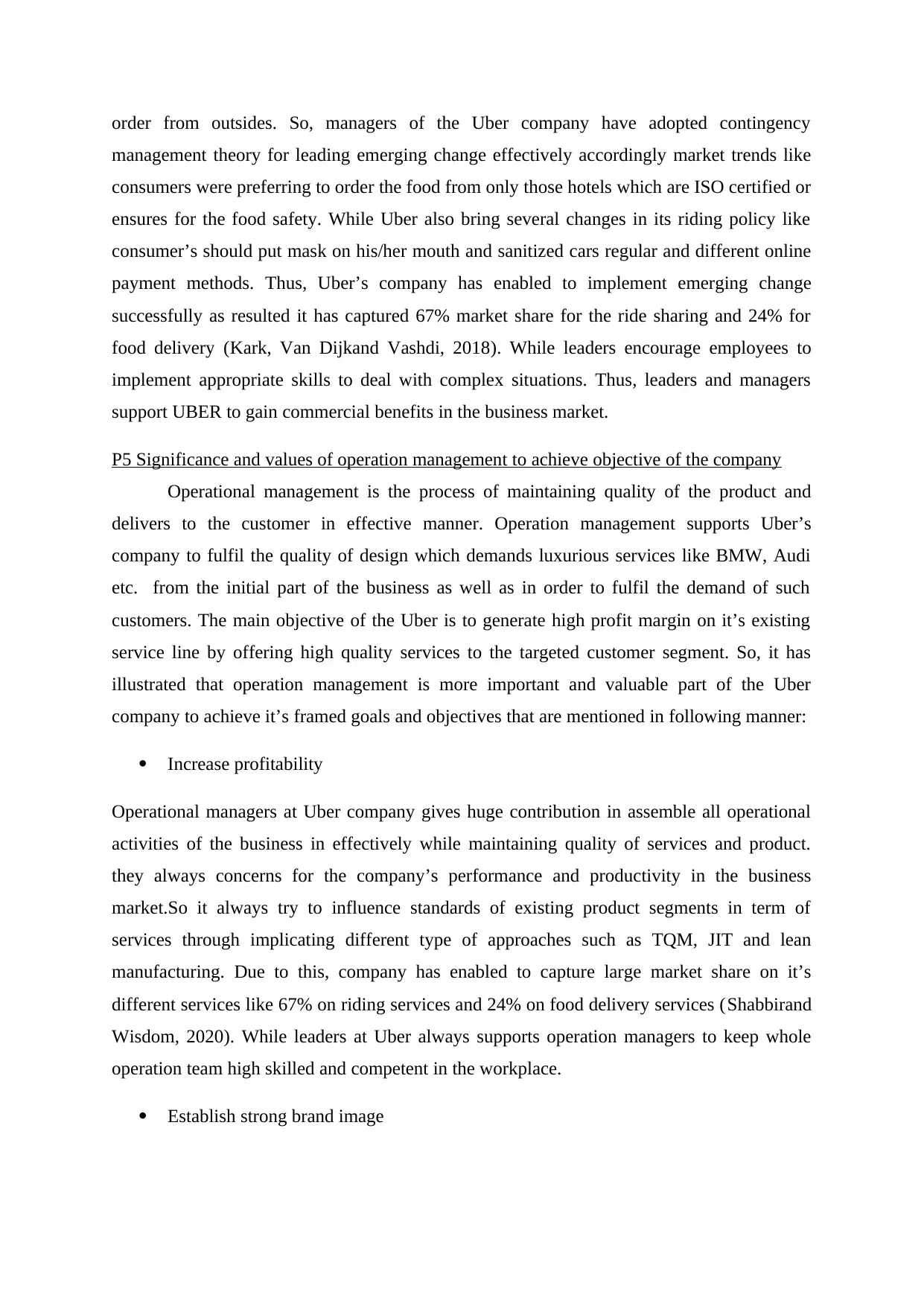
order from outsides. So, managers of the Uber company have adopted contingency
management theory for leading emerging change effectively accordingly market trends like
consumers were preferring to order the food from only those hotels which are ISO certified or
ensures for the food safety. While Uber also bring several changes in its riding policy like
consumer’s should put mask on his/her mouth and sanitized cars regular and different online
payment methods. Thus, Uber’s company has enabled to implement emerging change
successfully as resulted it has captured 67% market share for the ride sharing and 24% for
food delivery (Kark, Van Dijkand Vashdi, 2018). While leaders encourage employees to
implement appropriate skills to deal with complex situations. Thus, leaders and managers
support UBER to gain commercial benefits in the business market.
P5 Significance and values of operation management to achieve objective of the company
Operational management is the process of maintaining quality of the product and
delivers to the customer in effective manner. Operation management supports Uber’s
company to fulfil the quality of design which demands luxurious services like BMW, Audi
etc. from the initial part of the business as well as in order to fulfil the demand of such
customers. The main objective of the Uber is to generate high profit margin on it’s existing
service line by offering high quality services to the targeted customer segment. So, it has
illustrated that operation management is more important and valuable part of the Uber
company to achieve it’s framed goals and objectives that are mentioned in following manner:
Increase profitability
Operational managers at Uber company gives huge contribution in assemble all operational
activities of the business in effectively while maintaining quality of services and product.
they always concerns for the company’s performance and productivity in the business
market.So it always try to influence standards of existing product segments in term of
services through implicating different type of approaches such as TQM, JIT and lean
manufacturing. Due to this, company has enabled to capture large market share on it’s
different services like 67% on riding services and 24% on food delivery services (Shabbirand
Wisdom, 2020). While leaders at Uber always supports operation managers to keep whole
operation team high skilled and competent in the workplace.
Establish strong brand image
management theory for leading emerging change effectively accordingly market trends like
consumers were preferring to order the food from only those hotels which are ISO certified or
ensures for the food safety. While Uber also bring several changes in its riding policy like
consumer’s should put mask on his/her mouth and sanitized cars regular and different online
payment methods. Thus, Uber’s company has enabled to implement emerging change
successfully as resulted it has captured 67% market share for the ride sharing and 24% for
food delivery (Kark, Van Dijkand Vashdi, 2018). While leaders encourage employees to
implement appropriate skills to deal with complex situations. Thus, leaders and managers
support UBER to gain commercial benefits in the business market.
P5 Significance and values of operation management to achieve objective of the company
Operational management is the process of maintaining quality of the product and
delivers to the customer in effective manner. Operation management supports Uber’s
company to fulfil the quality of design which demands luxurious services like BMW, Audi
etc. from the initial part of the business as well as in order to fulfil the demand of such
customers. The main objective of the Uber is to generate high profit margin on it’s existing
service line by offering high quality services to the targeted customer segment. So, it has
illustrated that operation management is more important and valuable part of the Uber
company to achieve it’s framed goals and objectives that are mentioned in following manner:
Increase profitability
Operational managers at Uber company gives huge contribution in assemble all operational
activities of the business in effectively while maintaining quality of services and product.
they always concerns for the company’s performance and productivity in the business
market.So it always try to influence standards of existing product segments in term of
services through implicating different type of approaches such as TQM, JIT and lean
manufacturing. Due to this, company has enabled to capture large market share on it’s
different services like 67% on riding services and 24% on food delivery services (Shabbirand
Wisdom, 2020). While leaders at Uber always supports operation managers to keep whole
operation team high skilled and competent in the workplace.
Establish strong brand image
Paraphrase This Document
Need a fresh take? Get an instant paraphrase of this document with our AI Paraphraser
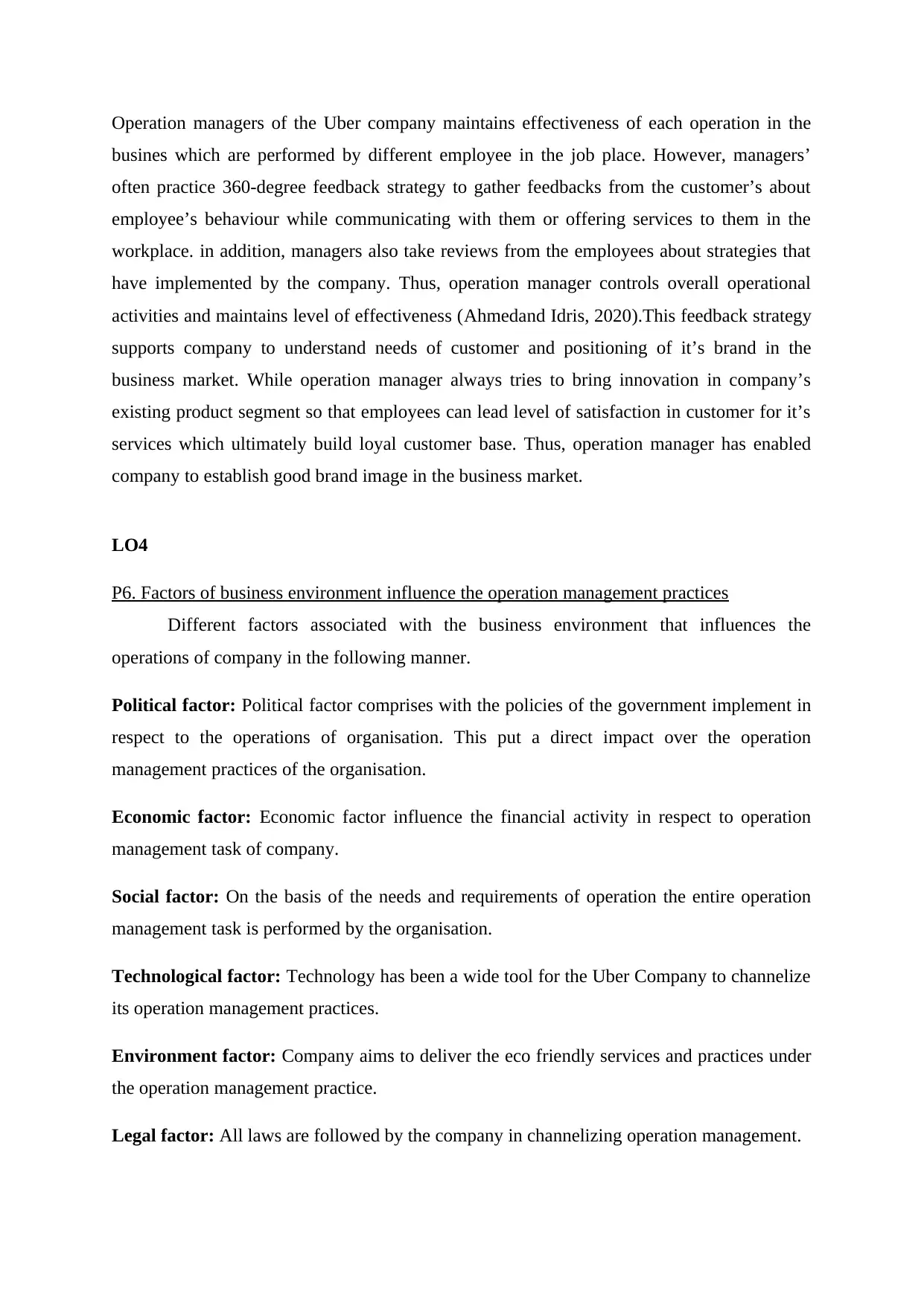
Operation managers of the Uber company maintains effectiveness of each operation in the
busines which are performed by different employee in the job place. However, managers’
often practice 360-degree feedback strategy to gather feedbacks from the customer’s about
employee’s behaviour while communicating with them or offering services to them in the
workplace. in addition, managers also take reviews from the employees about strategies that
have implemented by the company. Thus, operation manager controls overall operational
activities and maintains level of effectiveness (Ahmedand Idris, 2020).This feedback strategy
supports company to understand needs of customer and positioning of it’s brand in the
business market. While operation manager always tries to bring innovation in company’s
existing product segment so that employees can lead level of satisfaction in customer for it’s
services which ultimately build loyal customer base. Thus, operation manager has enabled
company to establish good brand image in the business market.
LO4
P6. Factors of business environment influence the operation management practices
Different factors associated with the business environment that influences the
operations of company in the following manner.
Political factor: Political factor comprises with the policies of the government implement in
respect to the operations of organisation. This put a direct impact over the operation
management practices of the organisation.
Economic factor: Economic factor influence the financial activity in respect to operation
management task of company.
Social factor: On the basis of the needs and requirements of operation the entire operation
management task is performed by the organisation.
Technological factor: Technology has been a wide tool for the Uber Company to channelize
its operation management practices.
Environment factor: Company aims to deliver the eco friendly services and practices under
the operation management practice.
Legal factor: All laws are followed by the company in channelizing operation management.
busines which are performed by different employee in the job place. However, managers’
often practice 360-degree feedback strategy to gather feedbacks from the customer’s about
employee’s behaviour while communicating with them or offering services to them in the
workplace. in addition, managers also take reviews from the employees about strategies that
have implemented by the company. Thus, operation manager controls overall operational
activities and maintains level of effectiveness (Ahmedand Idris, 2020).This feedback strategy
supports company to understand needs of customer and positioning of it’s brand in the
business market. While operation manager always tries to bring innovation in company’s
existing product segment so that employees can lead level of satisfaction in customer for it’s
services which ultimately build loyal customer base. Thus, operation manager has enabled
company to establish good brand image in the business market.
LO4
P6. Factors of business environment influence the operation management practices
Different factors associated with the business environment that influences the
operations of company in the following manner.
Political factor: Political factor comprises with the policies of the government implement in
respect to the operations of organisation. This put a direct impact over the operation
management practices of the organisation.
Economic factor: Economic factor influence the financial activity in respect to operation
management task of company.
Social factor: On the basis of the needs and requirements of operation the entire operation
management task is performed by the organisation.
Technological factor: Technology has been a wide tool for the Uber Company to channelize
its operation management practices.
Environment factor: Company aims to deliver the eco friendly services and practices under
the operation management practice.
Legal factor: All laws are followed by the company in channelizing operation management.
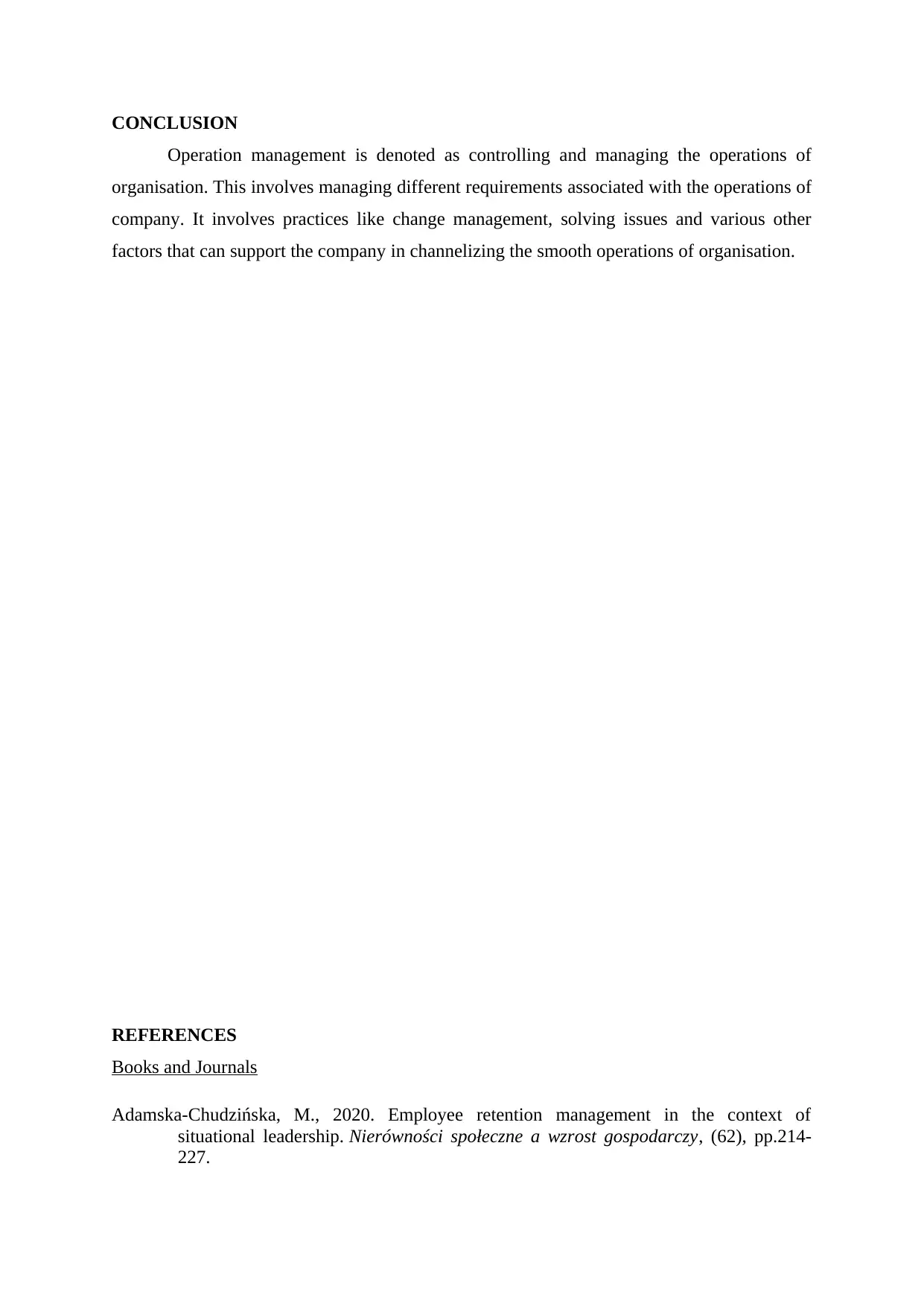
CONCLUSION
Operation management is denoted as controlling and managing the operations of
organisation. This involves managing different requirements associated with the operations of
company. It involves practices like change management, solving issues and various other
factors that can support the company in channelizing the smooth operations of organisation.
REFERENCES
Books and Journals
Adamska-Chudzińska, M., 2020. Employee retention management in the context of
situational leadership. Nierówności społeczne a wzrost gospodarczy, (62), pp.214-
227.
Operation management is denoted as controlling and managing the operations of
organisation. This involves managing different requirements associated with the operations of
company. It involves practices like change management, solving issues and various other
factors that can support the company in channelizing the smooth operations of organisation.
REFERENCES
Books and Journals
Adamska-Chudzińska, M., 2020. Employee retention management in the context of
situational leadership. Nierówności społeczne a wzrost gospodarczy, (62), pp.214-
227.
⊘ This is a preview!⊘
Do you want full access?
Subscribe today to unlock all pages.

Trusted by 1+ million students worldwide
1 out of 13
Related Documents
Your All-in-One AI-Powered Toolkit for Academic Success.
+13062052269
info@desklib.com
Available 24*7 on WhatsApp / Email
![[object Object]](/_next/static/media/star-bottom.7253800d.svg)
Unlock your academic potential
Copyright © 2020–2025 A2Z Services. All Rights Reserved. Developed and managed by ZUCOL.





